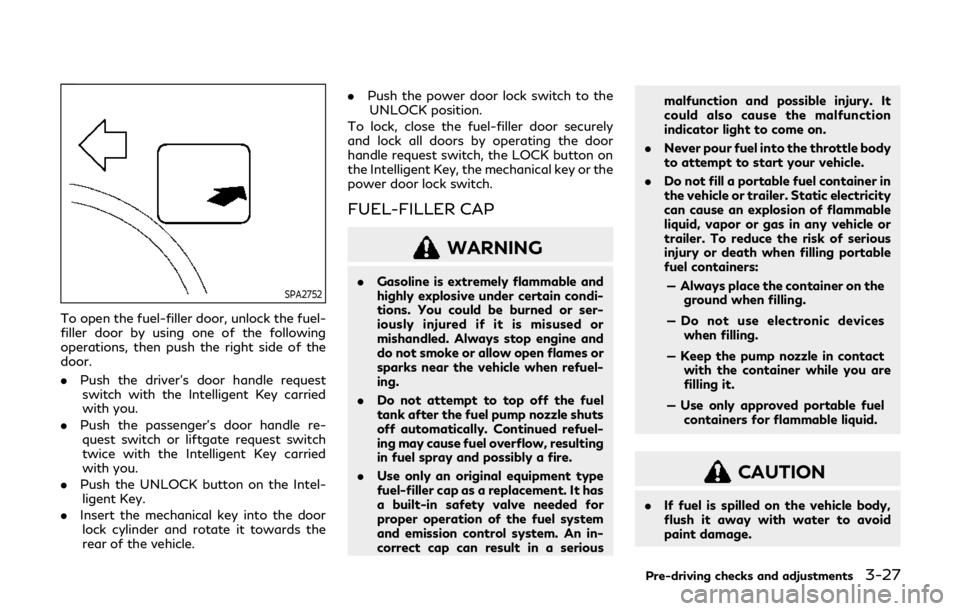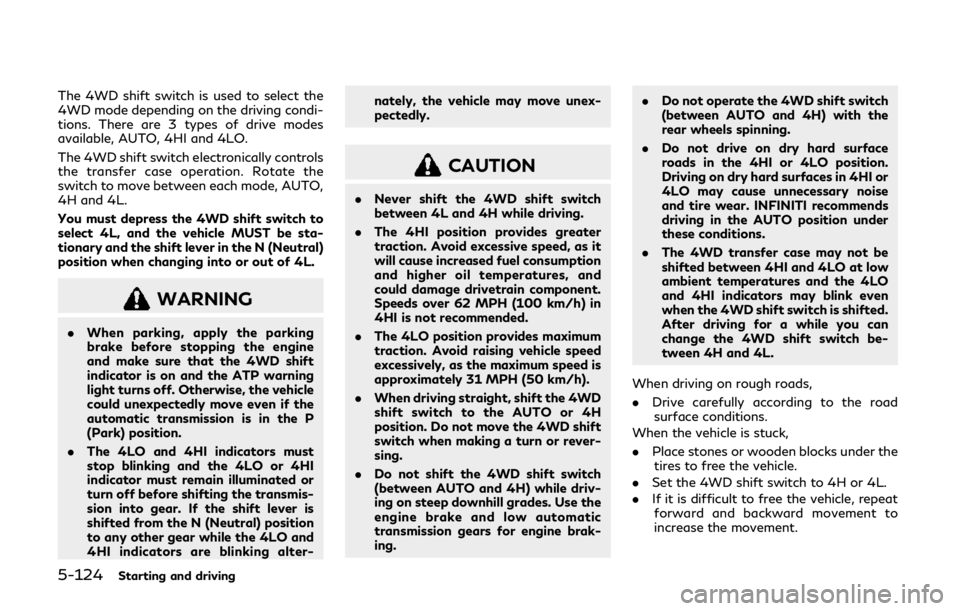fuel type INFINITI QX80 2019 Owner's Manual
[x] Cancel search | Manufacturer: INFINITI, Model Year: 2019, Model line: QX80, Model: INFINITI QX80 2019Pages: 524, PDF Size: 2.45 MB
Page 186 of 524

3-16Pre-driving checks and adjustments
SPA2718
Type A
JVP0156X
Type B
LOCK button
UNLOCK button
Power liftgate button
PANIC button
Remote engine start button
HOW TO USE REMOTE KEYLESS
ENTRY SYSTEM
When you lock or unlock the doors or the
liftgate, the hazard indicator will flash and
the horn (or the outside chime) will sound as
a confirmation. For details, see “Setting
hazard indicator and horn mode” (P.3-17).
Locking doors and fuel-filler door
1. Move the shift lever to the P (Park)position, push the ignition switch to the
OFF position and make sure you carry
the Intelligent Key with you.*
2. Close all the doors and the liftgate.
3. Push the LOCK
buttonon the
Intelligent Key.
4. All the doors, the liftgate and fuel-filler door will lock.
5. The hazard indicator flashes twice and the horn chirps once.
*: Doors will lock with the Intelligent Key
while the ignition switch is in the ACC or ON
position.
Unlocking doors and fuel-filler door
1. Push the UNLOCKbuttonon the
Intelligent Key once.
2. The hazard indicator flashes once. The driver’s door and fuel-filler door will
unlock.
The puddle light and the passenger cabin
illumination will illuminate and stay on
for a short period of time.
3. Push the UNLOCK
button on the
Intelligent Key again within 60 seconds.
4. The hazard indicator flashes once again. All the doors will unlock.
All doors will be locked automatically unless
one of the following operations is performed
within 1 minute after pushing the UNLOCK
button on the Intelligent Key while the doors
are locked. If during this 1-minute time
period, the UNLOCK button on the Intelli-
gent Key is pushed, all doors will be locked
automatically after another 1 minute.
. Opening any door
. Pushing the ignition switch
Opening windows
To open the windows, push the door UN-
LOCKbutton on the Intelligent Key for
about 3 seconds after the door is unlocked.
To stop opening, release the UNLOCK
Page 197 of 524

SPA2752
To open the fuel-filler door, unlock the fuel-
filler door by using one of the following
operations, then push the right side of the
door.
.Push the driver’s door handle request
switch with the Intelligent Key carried
with you.
. Push the passenger’s door handle re-
quest switch or liftgate request switch
twice with the Intelligent Key carried
with you.
. Push the UNLOCK button on the Intel-
ligent Key.
. Insert the mechanical key into the door
lock cylinder and rotate it towards the
rear of the vehicle. .
Push the power door lock switch to the
UNLOCK position.
To lock, close the fuel-filler door securely
and lock all doors by operating the door
handle request switch, the LOCK button on
the Intelligent Key, the mechanical key or the
power door lock switch.
FUEL-FILLER CAP
WARNING
. Gasoline is extremely flammable and
highly explosive under certain condi-
tions. You could be burned or ser-
iously injured if it is misused or
mishandled. Always stop engine and
do not smoke or allow open flames or
sparks near the vehicle when refuel-
ing.
. Do not attempt to top off the fuel
tank after the fuel pump nozzle shuts
off automatically. Continued refuel-
ing may cause fuel overflow, resulting
in fuel spray and possibly a fire.
. Use only an original equipment type
fuel-filler cap as a replacement. It has
a built-in safety valve needed for
proper operation of the fuel system
and emission control system. An in-
correct cap can result in a serious malfunction and possible injury. It
could also cause the malfunction
indicator light to come on.
. Never pour fuel into the throttle body
to attempt to start your vehicle.
. Do not fill a portable fuel container in
the vehicle or trailer. Static electricity
can cause an explosion of flammable
liquid, vapor or gas in any vehicle or
trailer. To reduce the risk of serious
injury or death when filling portable
fuel containers:
— Always place the container on the ground when filling.
— Do not use electronic devices when filling.
— Keep the pump nozzle in contact with the container while you are
filling it.
— Use only approved portable fuel containers for flammable liquid.
CAUTION
. If fuel is spilled on the vehicle body,
flush it away with water to avoid
paint damage.
Pre-driving checks and adjustments3-27
Page 374 of 524

5-124Starting and driving
The 4WD shift switch is used to select the
4WD mode depending on the driving condi-
tions. There are 3 types of drive modes
available, AUTO, 4HI and 4LO.
The 4WD shift switch electronically controls
the transfer case operation. Rotate the
switch to move between each mode, AUTO,
4H and 4L.
You must depress the 4WD shift switch to
select 4L, and the vehicle MUST be sta-
tionary and the shift lever in the N (Neutral)
position when changing into or out of 4L.
WARNING
.When parking, apply the parking
brake before stopping the engine
and make sure that the 4WD shift
indicator is on and the ATP warning
light turns off. Otherwise, the vehicle
could unexpectedly move even if the
automatic transmission is in the P
(Park) position.
. The 4LO and 4HI indicators must
stop blinking and the 4LO or 4HI
indicator must remain illuminated or
turn off before shifting the transmis-
sion into gear. If the shift lever is
shifted from the N (Neutral) position
to any other gear while the 4LO and
4HI indicators are blinking alter- nately, the vehicle may move unex-
pectedly.
CAUTION
.
Never shift the 4WD shift switch
between 4L and 4H while driving.
. The 4HI position provides greater
traction. Avoid excessive speed, as it
will cause increased fuel consumption
and higher oil temperatures, and
could damage drivetrain component.
Speeds over 62 MPH (100 km/h) in
4HI is not recommended.
. The 4LO position provides maximum
traction. Avoid raising vehicle speed
excessively, as the maximum speed is
approximately 31 MPH (50 km/h).
. When driving straight, shift the 4WD
shift switch to the AUTO or 4H
position. Do not move the 4WD shift
switch when making a turn or rever-
sing.
. Do not shift the 4WD shift switch
(between AUTO and 4H) while driv-
ing on steep downhill grades. Use the
engine brake and low automatic
transmission gears for engine brak-
ing. .
Do not operate the 4WD shift switch
(between AUTO and 4H) with the
rear wheels spinning.
. Do not drive on dry hard surface
roads in the 4HI or 4LO position.
Driving on dry hard surfaces in 4HI or
4LO may cause unnecessary noise
and tire wear. INFINITI recommends
driving in the AUTO position under
these conditions.
. The 4WD transfer case may not be
shifted between 4HI and 4LO at low
ambient temperatures and the 4LO
and 4HI indicators may blink even
when the 4WD shift switch is shifted.
After driving for a while you can
change the 4WD shift switch be-
tween 4H and 4L.
When driving on rough roads,
. Drive carefully according to the road
surface conditions.
When the vehicle is stuck,
. Place stones or wooden blocks under the
tires to free the vehicle.
. Set the 4WD shift switch to 4H or 4L.
. If it is difficult to free the vehicle, repeat
forward and backward movement to
increase the movement.
Page 461 of 524

The following descriptions are provided to
give you a better understanding of the
scheduled maintenance items that should
be regularly checked or replaced. The main-
tenance schedule indicates at which mile-
age/time intervals each item requires
service.
In addition to scheduled maintenance, your
vehicle requires that some items be checked
during normal day-to-day operation. Refer
to “General maintenance” (P.9-2).
Items marked with “*” are recommended by
INFINITI for reliable vehicle operation. You
are not required to perform maintenance on
these items in order to maintain the warran-
ties which come with your vehicle. Other
maintenance items and intervals are re-
quired.
When applicable, additional information can
be found in the “8. Do-it yourself” section of
this manual.
NOTE:
INFINITI does not advocate the use of non-
OEM approved aftermarket flushing sys-
tems and strongly advises against perform-
ing these services on an INFINITI product.
Many of the aftermarket flushing systems
use non-OEM approved chemicals or sol-
vents, the use of which has not been
validated by INFINITI.
For recommended fuel, lubricants, fluids,grease, and refrigerant, refer to “Capacities
and recommended fluids/lubricants” (P.10-
2) of this manual.
EMISSION CONTROL SYSTEM
MAINTENANCE
Drive belt*:
Check engine drive belt for wear, fraying or
cracking and for proper tension. Replace any
damaged drive belt.
Engine air filter:
Replace at specified intervals. When driving
for prolonged periods in dusty conditions,
check/replace the filter more frequently.
Engine coolant*
Replace coolant at the specified interval.
When adding or replacing coolant, be sure to
use only Genuine NISSAN Long Life Anti-
freeze/Coolant (blue) or equivalent with the
proper mixture. (Refer to “Engine cooling
system” (P.8-4) to determine the proper
mixture for your area.)
NOTE:
Mixing any other type of coolant or the use
of non-distilled water may reduce the
recommended service interval of the cool-
ant.
Engine oil and oil filter:
Replace engine oil and oil filter at the
specified intervals. For recommended oil
grade and viscosity refer to “Capacities and
recommended fluids/lubricants” (P.10-2).
Engine valve clearance*:
Inspect only if valve noise increases. Adjust
valve clearance if necessary.
Evaporative emissions control vapor lines*:
Check vapor lines for leaks or looseness.
Tighten connections or replace parts as
necessary.
Fuel lines*:
Check the fuel hoses, piping and connections
for leaks, looseness, or deterioration. Tight-
en connections or replace parts as necessary.
Spark plugs:
Replace at specified intervals. Install new
plugs of the type as originally equipped.
CHASSIS AND BODY MAINTE-
NANCE
Brake lines and cables:
Visually inspect for proper installation.
Check for chafing, cracks, deterioration,
and signs of leaking. Replace any deterio-
rated or damaged parts immediately.
Maintenance and schedules9-5
EXPLANATION OF SCHEDULED
MAINTENANCE ITEMS
Page 465 of 524

MAINTENANCE OP-
ERATION
Perform at number of
miles, kilometers or
months, whichever
comes first.Miles × 1,000
(km × 1,000) Months MAINTENANCE INTERVAL
65
(104) 78 70
(112) 84 75
(120) 90 80
(128) 96 85
(136) 102 90
(144) 108 95
(152) 114 100
(160) 120 105
(168) 126 110
(176) 132 115
(184) 138 120
(192) 144
Drive belt See NOTE (1) I*I*I*I* I* I*
Air cleaner filter See NOTE (2) RR
EVAP vapor lines I*I* I*
Fuel lines I*I* I*
Fuel filter See NOTE (3)
Engine coolant* See NOTE (4) (5)
Engine oil R R R R R R R R R R R R
Engine oil filter R R R R R R R R R R R R
Spark plugs See NOTE (6) Replace every 105,000 miles (168,000 km)
Intake and exhaust valve
clearance* See NOTE (7)
NOTE:
(1) After 40,000 miles (64,000 km) or 48
months, inspect every 10,000 miles
(16,000 km) or 12 months. Replace the
drive belt if found damaged.
(2) If operating mainly in dusty conditions,
more frequent maintenance may be re-
quired.
(3) Periodic maintenance is not required.
(4) First replacement interval is 105,000
miles (168,000 km) or 84 months. After first replacement, replace every 75,000
miles (120,000 km) or 60 months.
(5) Use only Genuine NISSAN Long Life
Antifreeze/Coolant (blue) or equivalent
with proper mixture ratio of 50% anti-
freeze and 50% demineralized or distilled
water. Mixing any other type of coolant or
the use of non-distilled water may reduce
the life expectancy of the factory fill cool-
ant.
(6) Replace spark plug when the plug gap
exceeds 0.053 in (1.35 mm) even if withinspecified replacement mileage.
(7) Periodic maintenance is not required.
However, if valve noise increases, inspect
valve clearance.
*: Maintenance items and intervals with “*”
are recommended by INFINITI for reliable
vehicle operation. The owner need not to
perform such maintenance in order to
maintain the emission warranty or manu-
facturer recall liability. Other maintenance
items and intervals are required.
Maintenance and schedules9-9
Page 474 of 524

10-2Technical and consumer information
The following are approximate capacities. The actual refill capacities may be a little different. When refilling, follow the procedure
instructed in the “8. Do-it-yourself” section to determine the proper refill capacity.
Fluid typeCapacity (approximate)
Recommended Fluids/Lubricants
Metric
Measure US
Measure Imperial
Measure
Fuel 98.4 L26 gal21-5/8 gal �ÂSee “Fuel information” (P.10-4).
Engine oil*1 With oil filter change 6.5 L6-7/8 qt 5-3/4 qt �ÂGenuine “NISSAN Motor Oil 0W-20 SN” is recommended.
� If the above motor oil is not available, use an equivalent motor oil that
matches the above grade and viscosity. For additional information,
see “Engine oil and oil filter recommendation” (P.10-6).
Drain and refill
*1: For additional information,
see “Changing engine oil and
filter” (P.8-6).
Without oil filter change 6.2 L6-1/2 qt 5-1/2 qt
Engine coolant
With reservoir 16.3 L 17-1/4 qt 14-3/8 qt
�ÂPre-diluted Genuine NISSAN Long Life Antifreeze/Coolant (blue) or
equivalent
Automatic transmission fluid (ATF) —— —�ÂGenuine NISSAN Matic S ATF
� INFINITI recommends using Genuine NISSAN Matic S ATF ONLY in
INFINITI automatic transmissions. Do not mix with other fluids. Using
fluids that are not equivalent to Genuine NISSAN Matic S ATF may
damage the automatic transmission. Damage caused by the use of
fluids other than as recommended is not covered under the INFINITI’s
New Vehicle Limited Warranty.
Transfer fluid —— —�ÂGenuine NISSAN Transfer Fluid for ATX90A transfer or equivalent
� Using transfer fluid other than Genuine NISSAN Transfer Fluid (or
equivalent) may damage the transfer, which is not covered by the
INFINITI New Vehicle Limited Warranty.
Front differential gear oil —— —�ÂGenuine NISSAN Differential Oil Hypoid Super GL-5 80W-90 or
equivalent conventional (non-synthetic) oil
Rear differential gear oil —— —�ÂGenuine NISSAN HYPOID FLUID·S1 GL-5 75W-80 or equivalent
Power steering fluid (PSF) Refill to the proper oil level according to the instructions
in the “8. Do-it-yourself” section. �Â
Genuine NISSAN PSF or equivalent
� DEXRON
TMVI type ATF may also be used.
Brake fluid �ÂGenuine NISSAN Super Heavy Duty Brake Fluid*4 or equivalent DOT
3
*4: Available in mainland U.S.A. through an INFINITI retailer.
Suspension fluid —— —�ÂGenuine NISSAN Hydraulic Suspension Fluid or equivalent
� Using Hydraulic Suspension fluid other than Genuine NISSAN
Hydraulic Suspension Fluid (or equivalent) will damage the Hydraulic
Suspension, which is not covered by the INFINITI new vehicle limited
warranty. See an INFINITI retailer for recommended hydraulic
suspension fluid.
Multi-purpose grease —— —�ÂNLGI No. 2 (Lithium soap base)
CAPACITIES AND RECOMMENDED
FLUIDS/LUBRICANTS
Page 478 of 524

10-6Technical and consumer information
damage to the engine. If any of the above
symptoms are encountered, have your ve-
hicle checked. It is recommended you visit an
INFINITI retailer for servicing.
However, now and then you may notice
light spark knock for a short time while
accelerating or driving up hills. This is no
cause for concern, because you get the
greatest fuel benefit when there is light
spark knock for a short time under heavy
engine load.
JVT0342X
API certification mark
API service symbol
ENGINE OIL AND OIL FILTER
RECOMMENDATION
Selecting the correct oil
It is essential to choose the correct grade,
quality, and viscosity engine oil to ensure
satisfactory engine life and performance,
see “Capacities and recommended fluids/
lubricants” (P.10-2). INFINITI recommends
the use of an energy conserving oil in order
to improve fuel economy.
Select only engine oils that meet the Amer-
ican Petroleum Institute (API) certificationor International Lubricant Standardization
and Approval Committee (ILSAC) certifica-
tion and SAE viscosity standard. These oils
have the API certification mark on the front
of the container. Oils which do not have the
specified quality label should not be used as
they could cause engine damage.Oil additives
INFINITI does not recommend the use of oil
additives. The use of an oil additive is not
necessary when the proper oil type is used
and maintenance intervals are followed.
Oil which may contain foreign matter or has
been previously used should not be used.